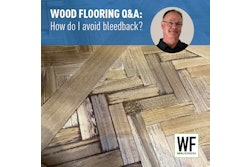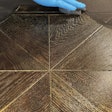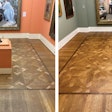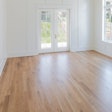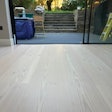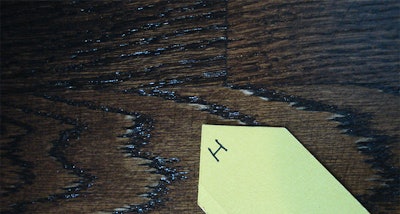
 The homeowner noticed light spots on the flooring following a refinish.
The homeowner noticed light spots on the flooring following a refinish.
The Homeowners' Issue
The homeowner wanted a solid wood floor stained dark with polyurethane oil-based finish to match other parts of the home. After the floor was completed by the flooring contractor, the homeowner noticed white/light spots in the stain. The homeowner contacted the refinisher, and he stated that because the homeowner wanted a dark color, he had to water-pop the floor, and this was the result. The homeowner said the color sample didn't have these spots. The refinisher said it did, and that the homeowner didn't look closely enough. The homeowner called a wood floor inspector.
Roy: The Inspector's Observations
When I inspected the floor, most light-colored areas the homeowner was concerned about were on the earlywood grain, which have a rougher texture than the summerwood. There were also a couple of areas approximately ¼ inch wide and up to 2 inches long where the stain was light. The raised grain on the earlywood is a common occurrence when water-popping wood such as oak, ash, maple, birch, etc. In some cases with water-popped wood, depending on the species, cut, and age, the wood will become rougher than normal. After the first coat of finish is applied, the rough grain is still higher than the film of the finish. While buffing in preparation of the next coat, the buffer nicks the top of the grain, removing the floor color and leaving the lighter spots. The other ¼-inch-wide lighter areas on the floor were consistent with the shape and size of toe soles of work boots knocking down the raised grain. My conclusion is that the refinisher failed to provide an acceptable overall uniform stain color.
RELATED: Sweaty Situation: Steamy Job Causes Unusual Stain Problem
Blake: The Attorney's Analysis
I am told that what happened in this case is a fairly common problem. However, the refinisher told the homeowner that the flooring samples had the same lighter spots. If he did indeed finish the floor to match the sample the homeowner approved, then it would be hard to say the refinisher did not complete the floor in accordance with the agreement. However, if the refinisher did not correctly perform the work, and these lighter spots were not on the sample, then the legal recourse will depend on who the homeowner had the contract with and what that agreement states. Assuming the contract was directly with the refinisher, then clearly the homeowner has a claim against the refinisher. On the other hand, if the homeowner's agreement was with a third party (such as a retailer) who subcontracted the work to the refinisher, then the homeowner's rights will depend on what the agreement with the retailer stated. In either case, the homeowner has a legal claim for the floor to be refinished correctly, but the route to do so will depend on what the contracts say.

















